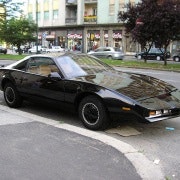The connected car: a smartphone with four wheels
When I was a kid, K.I.T.T. from Knight Rider was the coolest car on TV. Long before MTV pimped anyone’s ride, K.I.T.T. was fully loaded with artificial intelligence, GPS capabilities, multiple screens and car-to-watch communication capability to help Michael Knight stop the bad guys from carrying out their nefarious plots. Back in the early '80s K.I.T.T. was pure science fiction. However, today’s connected cars are turning science fiction into reality.
Audi recently launched the S3 Sportback, the first car to market that uses 4G LTE technology to connect the car to the internet. Audi expects it will increase the options for in-car infotainment such as movies, communication, navigation systems and streaming web radio. General Motors is partnering with AT&T, and expects to have 4G LTE service in its vehicles as soon as summer 2014. But the connected car goes beyond infotainment.
Take ParkMe, a Machine-to-Machine (M2M) application that uses wireless sensor technology to find available parking spots; or Automatic, a diagnostic app for reporting any problems and guiding you to the nearest auto shop or parts supplier. As cars get smarter, apps like these will integrate into a dashboard touchscreen.
With your in-car experience expected to change dramatically over the next five years, here’s a quick look at what’s driving up in our near future:
GigaOm’s Kevin Fitchard just reported on a new location-based ad format which is currently being tested on some Ford, Chrysler, Toyota, Honda, Subaru and Porsche vehicle models:
“When your car is connected, your car stereo is too. That means it isn’t just your navigation system getting your GPS coordinates, but also potential radio advertisers trying to sell you concert tickets or toasted sandwiches.”
And how about adaptive cruise control, where your vehicle automatically speeds up or slows down to keep pace with the car ahead of you? In the 2014 Ford Fusion, when the car senses a potential collision, the brakes pre-charge and increase sensitivity, to protect you from an accident. The Nissan Teana also has a blind spot warning radar system. Instead of using scanners and radar to avoid accidents, drivers may start to rely on cars communicating with each other. In fact, in 1999, the US Federal Communication Commission (FCC) allocated 75 MHz of spectrum at 5.9 GHz for this purpose and adopted technical and service rules to ensure interoperability standards would be in place.
Which brings us to cars that drive themselves. According to Google co-founder Sergey Brin in an interview with CNET’s Donna Tam, we won’t have to wait long.
“You can count on one hand the number of years it will take before ordinary people can experience this,” Brin said in November 2012. And ExtremeTech’s Bill Howard reports that Ford expects to have a self-driving car on the road by 2017, which will “take over your morning commute on clogged freeways”.
So where do service providers fit it in to our connected car future?
Well, AT&T and Verizon recognise an opportunity when they see one: ”There’s an opportunity to do amazing things with the car,” said Glenn Lurie, president of emerging devices for AT&T in an interview with CNET about AT&T’s partnership with GM.
“The excitement is you’re taking a car and turning it into a smartphone with four wheels.”
And then there’s Mercedes Benz’s mbrace system, powered by Verizon, which connects your car with a suite of apps, including geo-fencing tools, so you will always know where your car is, where it has been, and sets up zones on a map your car can’t enter.
To date, the role of most service providers has been limited to providing connectivity to connected cars, worth approximately 2 per cent of the overall connected car market. But big data offers an opportunity that could change their role. After all, service providers are already experienced with monetising data, and adding users’ daily travel habits will only enhance the information they can use in targeting products and services to their customers.
After all, why should companies like BMW and Mercedes build data centers when service providers already have them? Local service providers could partner with car manufacturers to aggregate the data and turn it into usable information.
Service providers who are currently managing connectivity could expand on that service to create sophisticated engagement models. They already have the technology – and experience – to develop user profiles for vehicles that recognise drivers and passengers, providing them with relevant content, and bill accordingly for those services.
Service providers have an opportunity to work closely with the auto industry, and the largest auto-makers are already engaged with the leading operators like AT&T and Verizon. But these engagements could evolve into a much more significant (and complex) game since service providers have the knowledge, resources and expertise needed to form mutually beneficial partnerships. However, the auto industry (and the opportunity it presents) is moving fast, and if telcos fail to jump on board, they may end up regretting the road not taken.
Arye Zacks is a contributor to the Amdocs Voices blog.















